America's King Tiger II
This German Royal Tiger tank, Panzerkampfwagn VI Ausf. B Tiger II, can be found at the National Armor and Cavalry Museum workshops in Fort Benning. Columbus, GA, USA. It is being restored before being exhibited in the new museum which is going to be built at Fort Benning.
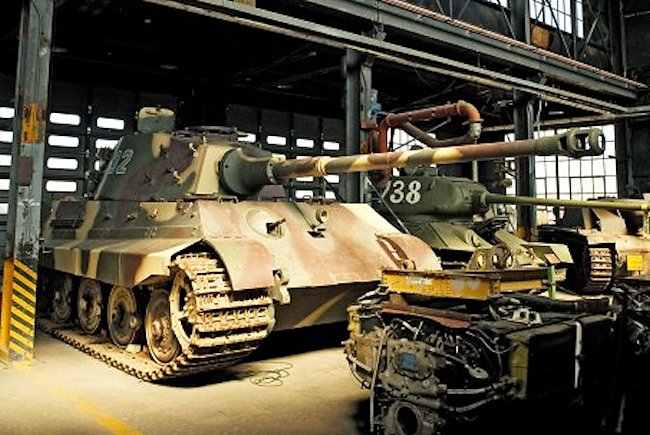
Photo taken of the King Tiger II tank at the National Armor and Cavalry Museum Workshops, Fort Benning, Columbus, GA, USA. (Photo - NACM)
Location
The King Tiger II tank is located at the National Armor and Cavalry Museum Workshops, Fort Benning, Columbus, GA, USA www.armorcavalrymuseum.org
Specifications
The Panzerkampfwagen VI Ausf. B Tiger, also commonly refered to as the Köningstiger, King Tiger, Royal Tiger or Tiger II tank was armed with a 88 mm (3.46 in) KwK43 L/71, 86 rounds and two or three 7.92 mm (3 in) MG 34 machine guns, 5800 round. Its armour ranged from 25mm to 180mm. It had a crew of five: commander, driver, gunner, loader and radio operator/machine gunner. It was powered by a V12 Maybach HL230 P30 690hp petrol engine. It weighed 69.8 tonnes. It had a top road speed of 41.5km/h (225.8mph). It had an operational range of 170 km (110 miles). Total production was 492 tanks. This particular tank, hull number 280243 and with the tactical number 332, belonged to the Schwere SS Panzerabteilung 501 (Heavy SS Tank Unit 501) which was part of the infamous Kampfgruppe Peiper.
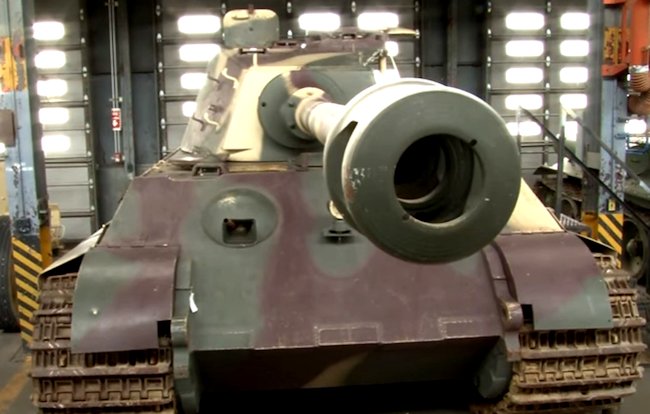
Photo taken of the King Tiger II tank at the National Armor and Cavalry Museum Workshops, Fort Benning, Columbus, GA, USA. (Photo - NACM)
The American King Tiger's History
As the only King Tiger tank (Pz.Kpfw. VI) In the Western Hemisphere '332' now sits proudly on display in the Patton Museum of Cavalry and Armour at Fort Knox, Kentucky awaiting a full restoration. For nearly 46 years it had rested at Aberdeen Proving Ground, Maryland, until it was transferred to the Patton Museum in August 1991. Since its move, the tank has been thoroughly examined and has undergone a cosmetic restoration by the museum staff.
Although it is one of only two surviving Tigers from Kampfgruppe Peiper (the other remaining on the battlefield at La Gleize, Belgium), very little of substance has been written about '332'. Several published works note that it was recovered along Route N33 near Petit Coo, Belgium, but no one has explained why It was abandoned there and why and how it was moved to Spa. To answer these questions. we have to go back to late December 1944 and look at the situation at that time.
On the morning Of Christmas eve, 1944. lead elements Of the American 740th Tank Battalion their final assault on the small Belgian town of La Gleize. Expecting heavy resistance. but encountering none, the tankers were amazed to find over 170 enemy armoured vehicles abandoned in and around the town. These vehicles were the remains of Kampfgruppe Peiper, who had abandoned the town late the night before.
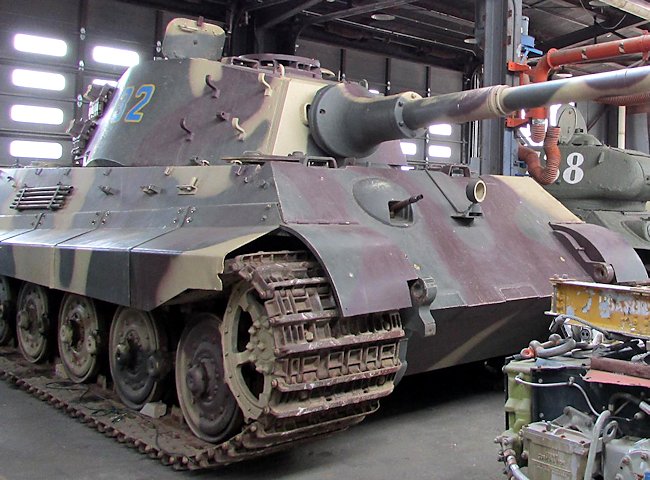
Photo taken of the King Tiger II tank at the National Armor and Cavalry Museum Workshops, Fort Benning, Columbus, GA, USA. (Photo - NACM)
On Christmas Day, C Company, along with 3rd Platoon of D Company 740th Tank Battalion, was assigned to aid the 119th Infantry in continuing the attack south along the N33 towards Trois Ponts. While this new attack was proceeding, a section from the 463rd Ordnance Evacuation Company rolled into La Gleize to begin evacuating recoverable vehicles. One of four such units attached to the US First Army, the mission Of 463rd was to recover abandoned Allied vehicles, as well as selected enemy vehicles and equipment for evaluation'.
One of the vehicles recovered in La Gleize was King Tiger '204', which had been abandoned in an open field near the town. Discovering that the vehicle could move under its own power, several soldiers of the 463rd undertook to drive the tank along a secondary road to Spa. After driving for several kilometres, the tank's engine caught fire and stalled.
Although the fire itself was put out by the automatic fire suppression system, the tank could not be restarted despite the soldiers' efforts and was abandoned where it stopped'.
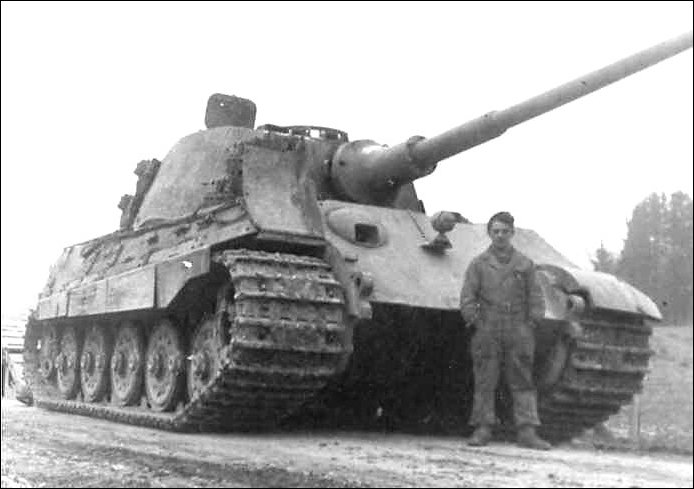
King Tiger II Tactical number 332, belonged to the Schwere SS Panzerabteilung 501 (Heavy SS Tank Unit 501) was part of the infamous Kampfgruppe Peiper.
While the first recovery was taking place, C Company's planned attack down highway N33 was underway. Rounding a bend in the road about four kilometres south of town, the lead American tanks were dismayed to spot a single King Tiger along the roadside ahead.
The lead Sherman quickly fired a single WP (white phosphorous) smoke round, which missed the target. To the American tank crew's amazement, the hatches on the King Tiger abruptly opened and its crew bailed out.
The Americans were so relieved at not receiving return fire. that they ceased fire and allowed the German crew to escape unharmed. Since it was no longer a threat, the tank was by-passed and left for the engineers or recovery crews. A Crew did come by and Stoped long enough to paint 'DON'T BLOW — EVACUATE' in white on the front slope before moving on.
Back in La Gleize, the section from the 463rd was ceasing operations for the day, disappointed at having failed in their recovery of Tiger '204'. The next morning, December 26, the unit continued down the N.33 and soon came across Tiger '332', which had been so quickly abandoned by its crew the day before. Since the tank had been marked for recovery, the section brought up their M 19 tractor-trailer combination, nicknamed 'Tank Taxi'. Accompanying it were two T5 (M32) ARVs and an M1A1 Heavy Wrecker.

PFC Gordon Love securing the King Tiger Tank with chains to the trailer, with Sergeant Charles Overstreet, Platoon Sgt, at the centre. On the hill in the distance is the village of St Gleize, Belgium. The M19 Tank Transporter consisted of a M20 Prime Mover (Diamond T 981) and M9 45-ton Trailer. On the right is a M1A1 Heavy Wrecker
Driving the recovery rig onto a nearby secondary road, the men inspected the Tiger and discovered that it was in very good condition. However, although it started immediately, it would not move. Further inspection revealed that it was frozen to the ground. The men scrounged several galIons of gasoline and freed the tank by pouring the fuel around the tracks and lighting the ground on fire'.
After it was freed, the new owners backed the tank down the secondary road to the waiting recovery vehicles. Needless to say, the M9 trailer was severely overloaded, having been designed to haul Sherman tanks and classified with a 45-ton restriction.
After chaining the Tiger down to the trailer, the M20 tractor truck was attached. The two M32 ARVs were attached at front and rear of the tractor-trailer combo, for use as additional traction for the tow as well as a brake for downhill movement.
Unable to travel faster than 2 mph, the road march took the convoy first into the town Of Stavelot, where they remained overnight. The next day (December 27), the unit headed north out of Stavelot along the road to Spa. Because of the weight and ungainliness of the load, the convoy was forced to stop with the advent of darkness. Unhooking the tractor and the ARVs, the trailer was left on the road and the crews retired to separate camp sites.
After parking the trailer, someone or something caused the rear left tires to catch fire. The next morning. the crew had to decide on how to proceed. Out of the 24 tyres on the trailer, eight had been burned off. Since no spares for either the tyres nor the complete trailer were available, it was decided to tow the trailer on the rims the remainder of the distance to the town of Spa. So it was. that on the afternoon of December 28, 1944. the Tiger was hauled into Spa.
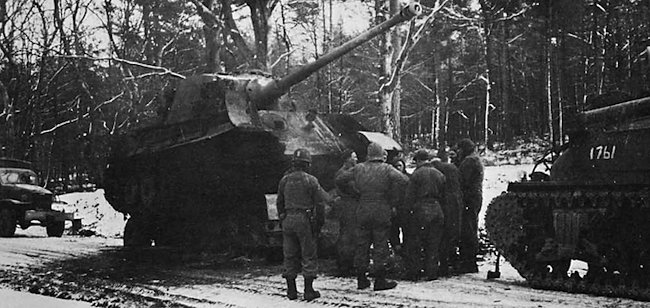
Problems with the trailer carrying the King Tiger II tank. Notice the burned tires on the trailer and M32 ARV on the right on the trailer and M32 ARV on the right.
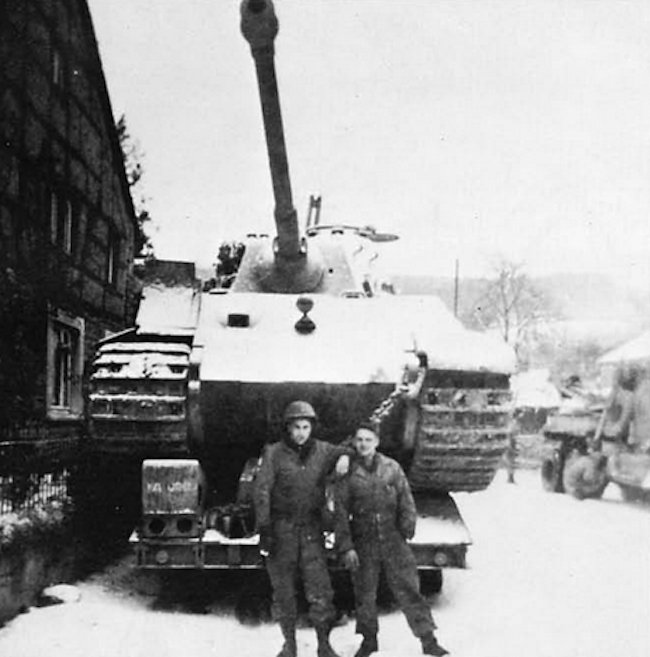
PFC Stevens and PFC Love in front of King Tiger II tank 332 on the morning of 27th December 1944 in Stavelot, Belgium.
Perhaps sensing that the tank might be further transported by rail, the crew drove the Tiger off the trailer and parked it next to the Spa railway station. As one of them painted '463 ORD EVAC' in white paint on the left-hand side of the turret. Another scratched his name under the right front fender. A third took a screw driver and carefully removed the data plate from the instrument panel as a personal souvenir. Having accomplished its near-impossible task under conditions of extreme cold and in close proximity to the front. the section moved out.
With the reduction of the 'Bulge', the 1st Army Headquarters returned to Spa in mid-February, 1945. To their surprise, there was a Tiger tank sitting at the railway station. Within days of 1st Army's return, Ordnance Technical Inspection Team number I (OTIT-I), assigned to the Army from APG, inspected the tank and marked it for transportation to the United States.
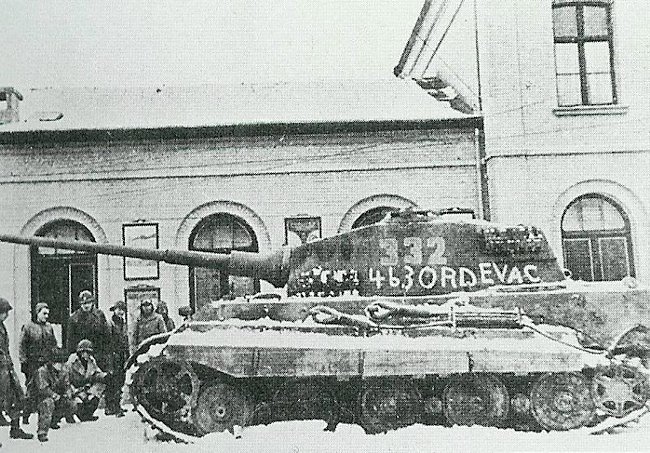
King Tiger II tank 332 with the words 463 ORDEVAC painted in white on the turret by the US Army waiting in the snow to be shipped to the USA outside Stavelot Railway Station in Belgium.
The team hand-painted 'OTIT-I' on the sides. front and rear of the Tiger in yellow paint. The tank was then loaded onto a captured heavy tank transporter and taken to Antwerp. from where it was shipped to the US. It appears that the odd 'cross' markings which have so confused historians, were added at this time. It is not known exactly when the vehicle arrived at the US Army Ordnance proving grounds at Aberdeen, but a soldier with an 8mm camera photographed the tank while it was still on its railcar, showing for the first time, a colour photo of its camouflage and markings".
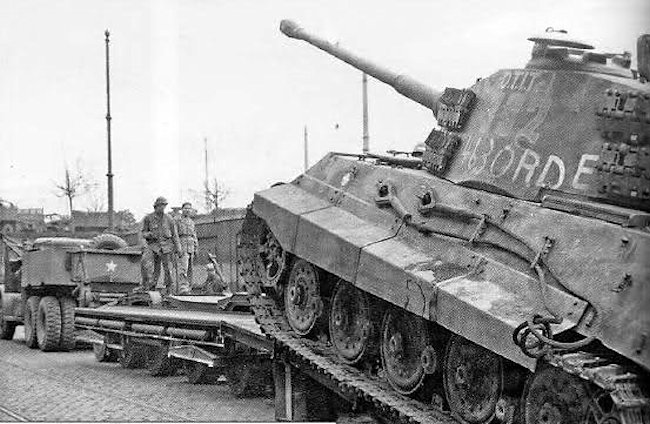
King Tiger II tank 332 with the words OTIT-1 463 ORDEVAC painted in white on the turret by the US Army waiting to be shipped to the USA. Additional track links had been fitted to the side of the turret before it was put onto the trailer.
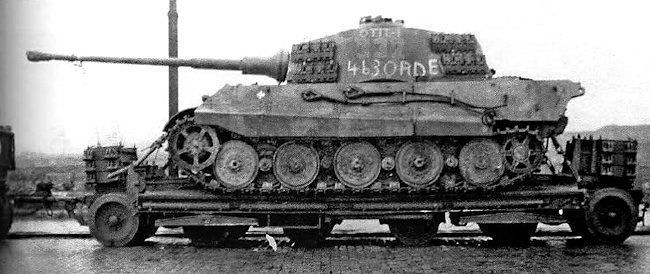
King Tiger II tank 332 with the words OTIT-1 463 ORDEVAC painted in white on the turret by the US Army waiting to be shipped to the USA.
While at Aberdeen, the vehicle was extensively tested, being driven until the mid-1950s. When all possible tests were exhausted, it was transferred to the Ordnance Museum.
In the early 1960s the tank was sectionalized by the Ordnance School and subsequently repainted inside and out. After several years at the school it was placed outside, with the cutaway sections covered over with sheet metal. Over the years the original paint scheme was lost and even the original turret numbers lost their shape in the repaintings.
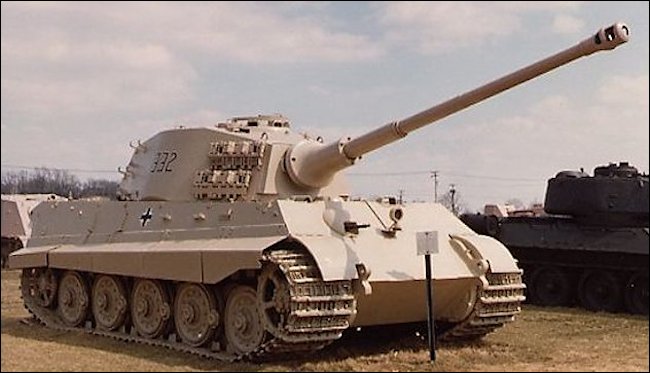
King Tiger II tank 332 on display at the US Army Ordnance Proving Grounds in Aberdeen.
In late 1990. the Patton Museum of Cavalry and Armour made a request to the Ordnance Museum asking for the King Tiger to be laterally transferred to the Patton Museum. This request was passed to the Army's Chief Of Military History (GMH), whose office controls all of the US Army Museums throughout the world, granted the request and arrangements for the shipment of the tank began, as part of a deal whereby a good MBT.70 prototype went to APG in return.
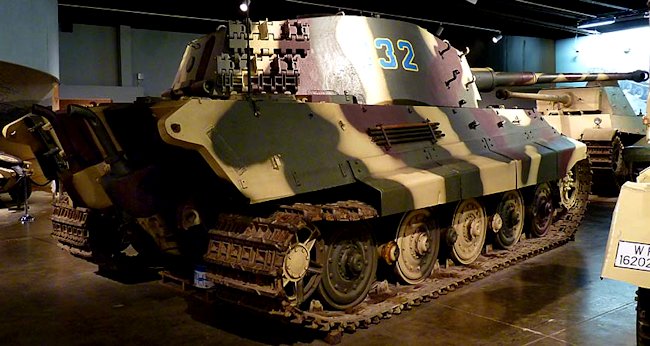
Photo taken of the King Tiger II tank at the Patton Museum of Cavalry and Armor, Fort Knox, Kentucky, USA before it was moved to Fort Benning.
In August 1991 the King Tiger arrived at Fort Knox. The tank arrived by rail car and a M88 Recovery Vehicle was dispatched to remove and transport it from the railhead to the museum storage facility. This proved to be a much more difficult task than initially expected. Even with part of the armour removed. The Tiger tank weighed more than 60 tons; all of it dead weight. The largest tow-bar that could be found was attached to the tank at the rear with large shackles, as the pins for the towbar itself would not fit.
As the tank was towed off the car the M88 began to make a turn towards the left (right side for the tank). At this point the shackle of the tank's right side collapsed into a pretzel shape and dropped off. This dropped the left towbar section to the ground and allowed the Tiger to free-roll towards a 14-ft ditch.
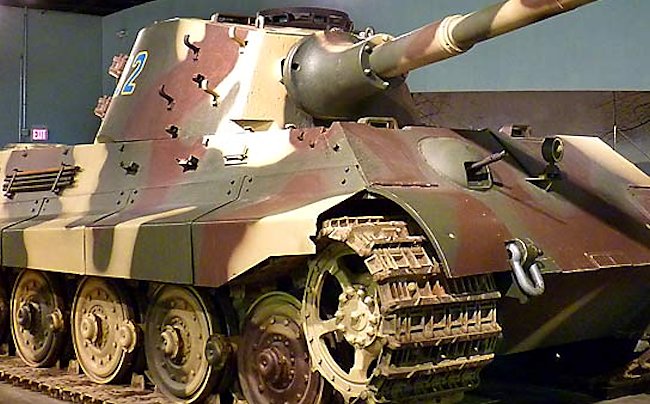
Photo taken of the King Tiger II tank at the Patton Museum of Cavalry and Armor, Fort Knox, Kentucky, USA before it was moved to Fort Benning.
Fortunately, the other shackle held, stopping the tank's rearward movement, and the only damage was a bent towbar. At this point it became obvious that, short of making the proper type of shackles, the only possible way of towing the vehicle was by cable. After about a 20-minute wait for the arrival of both additional towing cables and the museum's M60Al medium tank (for use as a 'trailing brake' vehicle). The Tiger was rerigged for cable-towing and another attempt was made to move the vehicle. The ground and pavement were slightly slippery and it took some time for the M88 to get enough traction for the 3-vehicle convoy to actually move.
The Tiger proved to be heavy enough to leave a pair of 30 inch wide by half inch deep track marks along the entire convoy route. Initially. It had been decided to store the tank inside one of the museum's storage buildings, but this proved to be impossible without the use of a towbar.
Several weeks went by before a pair of steel shackles, capable of handling the Tiger, were constructed. During this wait, the museum staff inspected the Tiger and decided that, for the time being, only a cosmetic restoration would be attempted. The plan called for the turret to be removed and so the tank was towed to the Boatwright Maintenance Facility. where a 75-ton crane was available to accomplish this task.
After removal of the turret. the hull was towed back to the museum restoration shop for partial teardown prior to the cosmetic restoration to begin. The work was completed in April 1992 and the tank was towed to the museum and placed on exhibit in time for the 1992 Armor Conference. It remains on display with its open side sealed with clear plexiglass to allow visitors a unique view of the King Tiger.
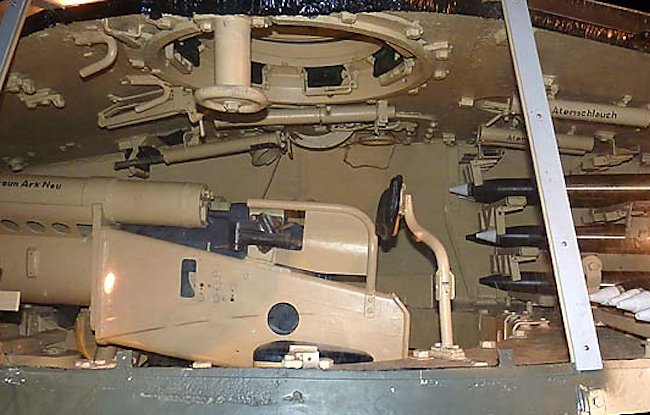
Inside view of the King Tiger's 88mm main gun and ammo racks behind it.
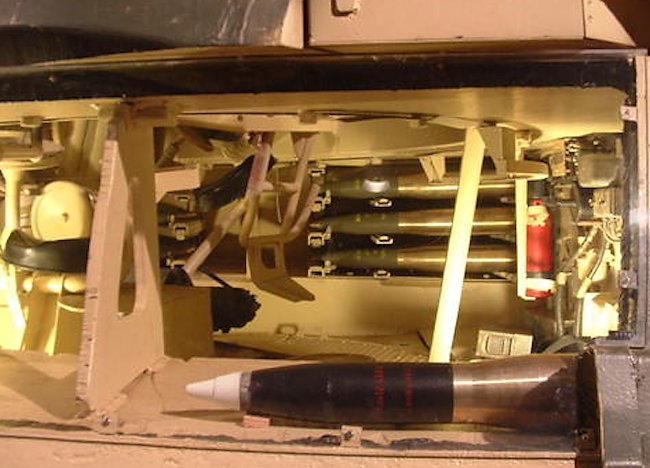
The cutaway section of the hull allowed visitors to see the lower Ammo racks on the King Tiger II tank at the Patton Museum of Cavalry and Armor, Fort Knox, Kentucky, USA before it was moved to Fort Benning.
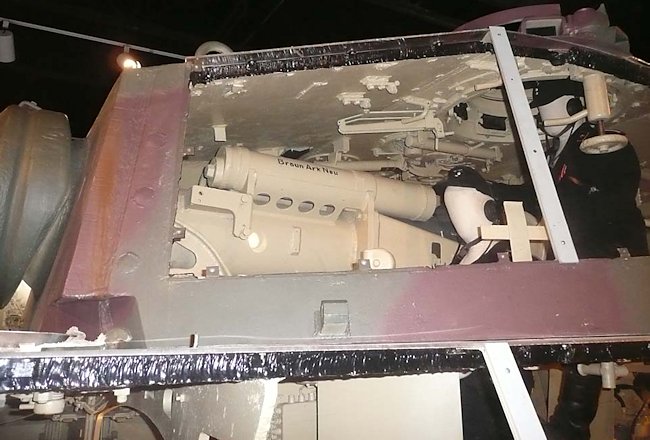
Later museum staff of the Patton Museum Of Cavalry and Armor, Fort Knox, added manikins in tank crew uniforms to represent the gunner and tank commander .
As a result of the Base Realignment and Closing (BRAC) decision by the U.S. Congress most of the tanks held at the Patton Museum of Cavalry and Armor at Fort Knox were transferred, in 2011, to the National Armor and Cavalry Museum workshops in Fort Benning. Columbus, GA, USA. This included the King Tiger tank. It is not on public display at present. A new museum is going to be built.
Article by Charles R. Lemons retired curator of the Patton Museum of Cavalry and Armor, Fort Knox, Kentucky, USA in the Wheels and Tracks Magazine.
Where can I find other preserved King Tiger Tanks?
- (Porsche turret) – Bovington Tank Museum
- Bovington Tank Museum
- Munster Panzer Museum
- December 44 Museum, La Gleize, Belgium
- Musée des Blindés, Saumur, France
- Schweizerisches Militärmuseum, Full, Switzerland
- Kubinka Tank Museum, Russia
- National Armor and Cavalry Museum, Fort Benning, GA, USA
- Wreck - Fontenay-Saint-Père, France
- Wreck - The Wheatcroft Collection, England
- Source - Pierre-Oliver Buan - http://the.shadock.free.fr/Surviving_Panzers.html
WW2 tank books

